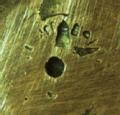Investigation of Boron Steel Spot Welds
The Metallographic Preparation Suite is used to prepare materials for characterisation. The facilities include precision cutting, hot / cold mounting and grinding / polishing of material samples including metal alloys, composites, ceramics, plastics and organic materials.
Research Challenge
In recent years, there has been considerable interest in characterising ultra-high strength boron steel spot welds with the aim of improving crash performance of automotive structures; in particular, this involves investigating th e variation in material properties from the nugget, through the heat affected zone (HAZ) and into the base metal.
e variation in material properties from the nugget, through the heat affected zone (HAZ) and into the base metal.
Boron steel spot welds are known to suffer from expulsions during welding, which can lead to porosity and reduced weld strength (shown in Figure 1 to the right). In order to investigate the variations in material properties and the extent of the porosities, it is necessary to section, polish and etch the welded pieces to perform the appropriate tests.
Outcomes
A Buehler IsoMet 5000 precision saw was used to section the weld. The sectioned weld was then mounted and polished using a 4 stage process with an EcoMet polisher. The samples were then etched using 2% nital to show microstructure. Vickers microhardness measurements were then made with an automated diamond indenter system.
The data from such a simple test provided important clues as to how the weld will behave when subjected to external mechanical forces. The hardness results, along with the etched microstructure, give a picture of the microstructural evolution as the weld cools from peak temperature to room temperature. This is enabling the development of models which can help to understand fracture of boron steel and should lead to improved crash performance.


